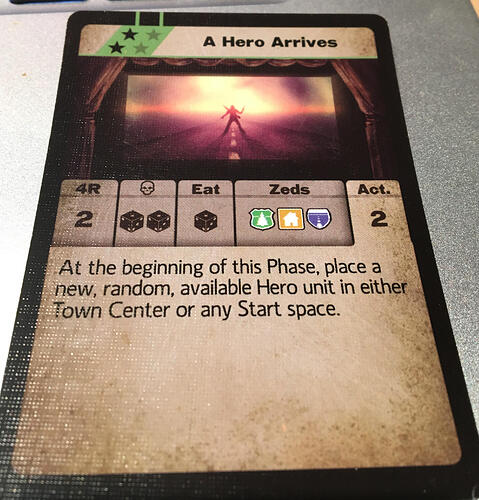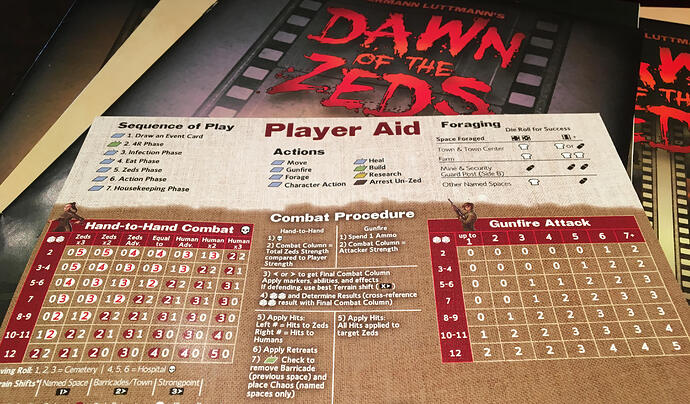Originally published at: http://statelyplay.com/2017/02/10/cardboard-critique-dawn-of-the-zeds-third-edition/
Tabletop •
In the comments following our review of Arkham Horror: The Card Game, there was short discussion of Fantasy Flight’s recent decision to split their rulebooks into two separate tomes, a Learn to Play guide and a Rules Reference. Victory Point Games has done FFG one better. Actually, four better. That’s right, when you pull the lid off of the latest edition of Dawn of the Zeds you’ll find no less than six rulebooks staring you in the face. Six. If the tech writer at VPG was writing A Song of Ice and Fire the series would have ended back in 2005.
I’ll admit, the six manuals seemed like a whole lot of overkill until I actually got this to the table. Dawn of the Zeds can be a massive, complex game if you want it to be, or it can be a simple struggle against invading hordes. Either way, it’s harder than hell and hell of a lot of fun.
Dawn of the Zeds covers well worn ground with its theme of, yep, a zombie apocalypse. Go ahead, roll your eyes. We’ll wait. Feel better? While it covers familiar territory, it does so with tongue planted firmly in cheek and never takes itself too seriously. There are biker gangs, mad scientists, civilians fighting for zombie rights, and even one chit labeled “Plague of Lawyers”. You can play heroes such as a dog named Pickles or a famous luchador named El Toro Loco. Yep, all this happens.
Gameplay is simple. In the center of the board lies the docile hamlet of Farmingdale which is under siege from hordes of the undead. Zombies courteously travel along the four roads that lead to Farmingdale, but if even one of them ever enters the town it’s game over. You lose. This will happen a lot.
[caption id=“attachment_1068” align=“aligncenter” width=“4032”]
The heroes stand ready.[/caption]If you can manage to hold out until the event deck runs out, you win. Kind of. The last card of the deck is randomly drawn and remains unseen until you get there and, once drawn, will tell you which epilogue to look up (there’s a Setup & Epilogue manual, of course) based on how ravaged the board is at game’s end. You might have won, but at what cost?
Each turn you will draw one event card that will walk you through the different phases of the game and randomize each phase. For example, one tab will tell you where to place new zombies this turn where another will tell you how many actions the heroes can spend this turn.
[caption id=“attachment_1069” align=“aligncenter” width=“2808”]
See, not all event cards in a cooperative game have to kick you in the teeth. I’m looking at you, Arkham Horror.[/caption]The zeds will do something terrible, usually advancing down one or more of the four tracks toward town, and then the heroes get to go. Their number of actions each turn varies based on the event card drawn, but each player will also have a “player action” token they can spend each turn. Player actions are not tied to their particular hero, but can be spent on any player unit making cooperative games very, very cooperative. One hero in a particularly helpful position may be activated by every player on a turn, leaving the other heroes to wonder what they did wrong. There’s little room for personal glory in Dawn of the Zeds, it’s all about tackling the big picture.
Combat is done via an old-fashioned Combat Results Table which takes into account the relative size of each side’s force and applies hits to both sides based on dice rolls. You’ll also have to deal with chaos as the Zeds destroy outlying towns and suburbs and refugees flee for the safety of town.
[caption id=“attachment_1070” align=“aligncenter” width=“4011”]
All you need to do is keep rolling 12 on two dice and you’ll be fine.[/caption]Simple, right? So, let’s talk about why those six rulebooks exist and what really separates Dawn of the Zeds from other games of the genre.
Dawn of the Zeds might be the most customizable game in existence. There’s so many different ways to play the game, starting with difficulty levels, that it’s hard to wrap your head around even after multiple plays. Unlike most cooperative titles which alter difficulty by having you add or remove cards, in Dawn of the Zeds changing the card composition is just the beginning.
Cards are helpfully color coded to indicate which difficulty level they belong to, but adding more difficult events is easy. Each level also changes the game by adding completely new mechanisms, pieces, strategies, and winning/losing conditions. The Basic game uses only basic zombies and heroes and consists of them moving slowly toward town while you try to mow them down. More advanced games will include Refugees, the National Guard, Barricades, gangs of evil humans, spreading diseases, super weapons, mad scientists, and much, much more.
[caption id=“attachment_1071” align=“aligncenter” width=“4032”]
There are far worse things than Zeds to encounter on the roads to Farmingdale.[/caption]Sounds great, doesn’t it? It is, but it’s also overwhelming. I’ve played at least a dozen solo games and have yet to play with half of the components in the box. Trust me, I’d like to–the super weapon and research mechanisms look very cool–but there’s so much going on at the level I’ve decided to play at, I can’t imagine adding more. Part of that revolves around the fact that I’ve yet to come close to sniffing a win. The game is freaking hard, and adding more difficulty just doesn’t seem like the way to go. At least not yet. Maybe someday I’ll chuckle that I used to think level 4 was hard as I try to discover the antidote to the Zed’s affliction while keeping the evil Dr. Marteuse in prison. Regardless, the game at Level 4 is a ton of fun, so knowing that there’s more in the box to discover someday is more positive than negative.
The complexity has other downsides, however. The rulebooks are riddled with exceptions and are hard as hell to read. You can’t go a couple lines without red text warning you that this rule only applies to Level X and above, or skip this line if playing the Basic game. Luckily, there’s a separate rule book for the Basic game, so you can get your feet wet without having to worry about exceptions, other difficulties, and about 90% of the game’s contents. Basic is very, very basic and you’ll spend that first Basic game staring at all the cool stuff in the box wondering when you can pull it out.
Don’t let all this complexity scare you. Dawn of the Zeds is one of the most intense and relentless cooperative or solo experiences you’ll ever have over a sheet of printed chipboard. It’s not just the fact that the Zeds don’t ever stop coming, it’s all the decisions you’ll have to make as the game goes on. You’ll need to find and wisely spend supplies. Watch your ammo, which is limited. Unlike a lot of other cooperative or solo games, there’s a lot here creating tension than just flipping over cards that beat you over the head.
[caption id=“attachment_1072” align=“aligncenter” width=“4020”]
The price of complexity.[/caption]Dawn of the Zeds can be played solo, cooperative, or even competitively if you’re feeling particularly insane. I’ve played both solo and cooperatively and I think it plays better as a solo game. The free-for-all way in which player actions are handled can create long, long conversations if playing with other people making a game that should only take an hour or so stretch over the two hour mark. That said, everyone is always involved in what’s going on so there’s no downtime with more players. Play competitively? Considering how badly I’m losing each game just playing against the board, I can’t even comprehend adding a human brain to the opposition.
The game’s presentation is top notch and I really have to hand it to whoever handles graphic design at VPG. While the complexity ramps up, cards are clearly marked to indicate if they should be included. Game phases are clearly indicated on each card making each event card double as a player aid. Events that are tied to specific game phases are indicated as such on the card by tabs, so there’s no confusion about when an event fires off. Even better, there are individual cards for just about every token in the game, telling you how it plays without having to dig up rules in one of the many rulebooks.
That compliment extends to all the cardboard tokens as well. Hit points are printed on the tokens and when enough hit points are taken, the tokens are flipped revealing weakened states for both heroes and Zeds. Zed special abilities are printed on chits that fit around the edge of the zombie tokens. All the action tokens are double-sided, allowing you to simply flip them over when an action is taken so you don’t have to keep track of who’s done what. Even the board is masterfully done, being double sided for different difficulty levels and having icons for each track that are easily recognizable and easy to follow.
If you’re a fan of solo or cooperative gaming and want something with more meat and strategy than games like Pandemic or Robinson Crusoe I can’t recommend Dawn of the Zeds enough. You’re not just getting a game, you’re getting a whole system of mechanisms that will take you a long while to unlock and unravel. Just be prepared to lose.






